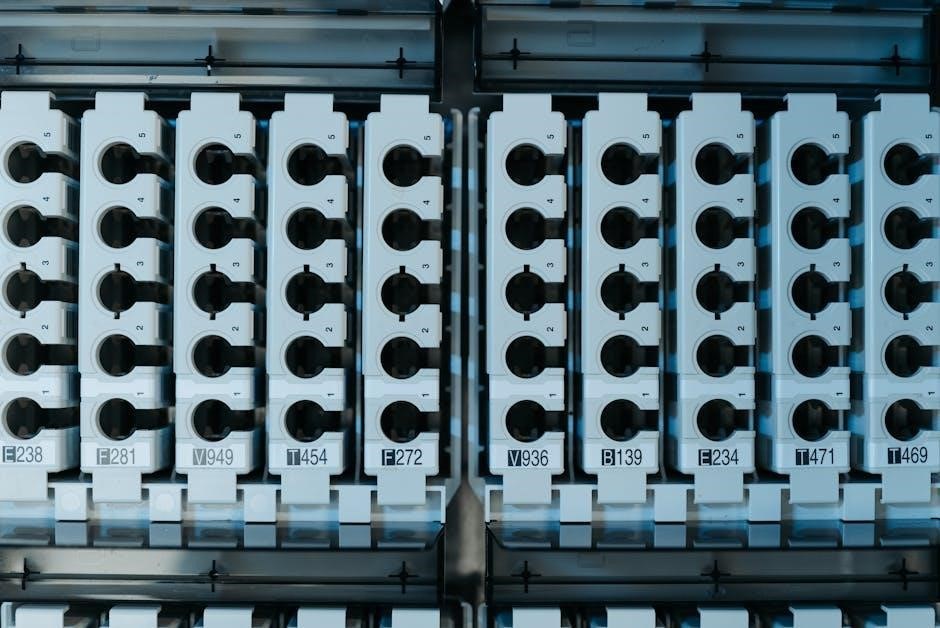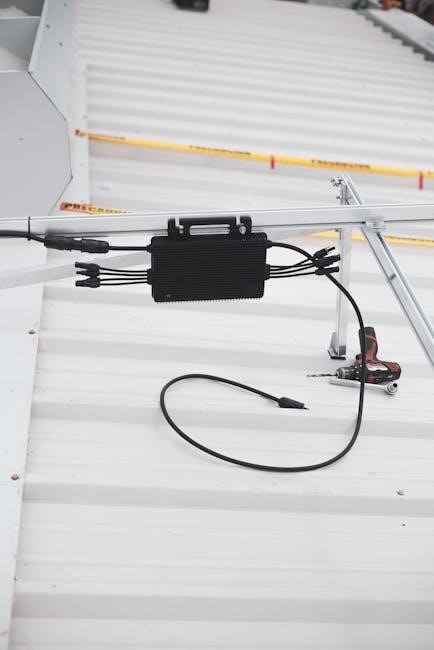solar panel wiring diagram pdf
A solar panel wiring diagram is a crucial guide for installing and understanding solar energy systems, ensuring safe and efficient connections for optimal performance.
1.1 Importance of Wiring Diagrams in Solar Energy Systems
Solar panel wiring diagrams are essential for understanding and installing solar energy systems safely and efficiently. They provide a visual representation of connections, ensuring components like panels, charge controllers, batteries, and inverters are linked correctly. A well-designed diagram helps prevent electrical hazards, optimizes system performance, and simplifies troubleshooting. Whether for a campervan, residential, or off-grid setup, a wiring diagram is a critical tool for both professionals and DIY enthusiasts to plan and execute installations accurately. It also ensures compliance with electrical standards and regulations.
Components of a Solar Panel Wiring Diagram
A solar panel wiring diagram includes essential components like solar panels, charge controllers, batteries, inverters, and electrical wiring, ensuring a clear and functional system layout.
2;1 Solar Panels
Solar panels are the cornerstone of any photovoltaic system, converting sunlight into electrical energy. They are typically represented in wiring diagrams as arrays of photovoltaic cells connected in series or parallel. These panels vary in type, including monocrystalline, polycrystalline, and thin-film, each offering different efficiencies and space requirements. The diagram illustrates how panels are grouped to achieve desired voltage and current levels, ensuring compatibility with other system components like charge controllers and inverters. Proper panel configuration is essential for maximizing energy output and system performance.
2.2 Charge Controllers
A charge controller is a critical component in solar panel wiring, regulating the flow of energy from panels to batteries. It prevents overcharging, ensuring batteries last longer and operate safely. The controller manages voltage and current, matching the panel’s output to the battery’s needs. Common types include PWM and MPPT, with MPPT offering higher efficiency by optimizing energy harvest. Proper installation, as shown in wiring diagrams, ensures system protection and efficiency. The controller also provides over-discharge protection and monitoring capabilities, enhancing overall system performance and reliability.
2.3 Batteries
Batteries are essential for storing excess energy generated by solar panels, ensuring power availability during low-light conditions. Deep cycle batteries are commonly used, designed to handle frequent charging and discharging. Wiring diagrams illustrate how batteries connect to panels and inverters, either in series or parallel to achieve desired voltage and capacity. Proper battery installation ensures reliable energy storage, while incorrect wiring can lead to system inefficiency or damage. Always follow safety guidelines and manufacturer recommendations when integrating batteries into your solar panel system.
2.4 Inverters
Inverters are crucial components that convert DC power from solar panels into AC power for household use. They ensure compatibility with appliances and the grid. Wiring diagrams detail how inverters connect to panels, batteries, and electrical systems. Proper installation and configuration are vital for efficiency and safety. Inverters also monitor system performance and optimize energy output. Different types, like string inverters or microinverters, offer varying benefits. Always follow the manufacturer’s guidelines and safety standards when wiring inverters into your solar panel system.
2.5 Electrical Wiring
Electrical wiring connects all components of a solar panel system, ensuring energy flows safely and efficiently. Proper wiring is critical for system performance and safety. It involves connecting solar panels to charge controllers, batteries, and inverters using appropriate wire gauges. Correct wiring ensures minimal power loss and prevents electrical hazards. Grounding techniques are essential to protect against voltage spikes and faults. Always use high-quality, weather-resistant materials and follow local electrical codes. A well-designed wiring system guarantees reliability and durability for your solar energy setup.

Types of Solar Panel Wiring Configurations
Solar panel wiring configurations include series, parallel, and a combination of both, each optimizing voltage, current, and system performance based on energy needs and installation requirements.
3.1 Series Configuration
In a series configuration, solar panels are connected end-to-end, increasing the total voltage while maintaining the same current. This setup is ideal for charging batteries or systems requiring higher voltage. Each panel’s positive terminal connects to the next panel’s negative terminal, creating a higher voltage output. However, all panels must have identical specifications to ensure balanced performance. Series wiring is straightforward but offers less flexibility, as shading or issues with one panel can affect the entire system. It is commonly used in grid-tied and off-grid setups for efficiency and simplicity.
3.2 Parallel Configuration
In a parallel configuration, solar panels are connected by linking positive terminals together and negative terminals together. This setup increases the total current while maintaining the same voltage, making it ideal for systems requiring higher current output. Parallel wiring allows each panel to operate independently, reducing the impact of shading or issues with one panel on the entire system. This configuration is highly flexible and commonly used in residential and RV setups to maximize energy production under varying conditions. Proper sizing of wires and protection devices is essential to ensure safe and efficient operation.
3.3 Combination of Series and Parallel
A combination of series and parallel wiring offers flexibility for solar panel systems, allowing users to achieve specific voltage and current requirements. This configuration involves grouping panels in series to increase voltage, then connecting these groups in parallel to boost current. It is ideal for larger systems or setups requiring precise voltage levels. Proper balancing of voltage and current across the combined strings is crucial to ensure efficiency and prevent potential issues. This hybrid approach maximizes energy production while accommodating varying system demands and applications.

Step-by-Step Installation Guide
A step-by-step guide outlines connecting panels, adding a charge controller, integrating batteries, and setting up the inverter, ensuring a safe and efficient solar energy system setup.
4.1 Connecting Solar Panels
Connecting solar panels involves linking them in series or parallel to achieve desired voltage and current. Series connections increase voltage, while parallel boosts current. Ensure panels are securely mounted and aligned for maximum sunlight exposure. Connect positive terminals to negative terminals, following polarity guidelines to avoid short circuits. Use appropriate wire sizes and connectors to minimize resistance. Refer to the wiring diagram for specific configurations, such as grid-tied or off-grid setups. Proper connections ensure efficient energy generation and system safety.
4.2 Adding a Charge Controller
A charge controller regulates the flow of energy from solar panels to batteries, preventing overcharging and ensuring efficient energy storage. Install the controller between the panels and batteries, following the wiring diagram to connect positive and negative terminals correctly. Choose a controller type (PWM or MPPT) based on system needs. Proper installation ensures safe energy transfer, protects batteries, and optimizes charging efficiency. Always match the controller’s capacity with the solar panel output to handle current effectively and avoid damage. This step is critical for maintaining system longevity and performance.
4.3 Integrating Batteries
Batteries store excess energy generated by solar panels for later use, ensuring a steady power supply during low sunlight or at night. Connect the batteries in series or parallel, depending on the system’s voltage and capacity requirements. Use the wiring diagram to ensure correct polarity when linking batteries to the charge controller and inverter. Properly securing terminals and adding fuses or circuit breakers safeguards against overcurrent and electrical hazards. Match battery capacity with energy needs and solar panel output for efficient energy storage and reliable performance. Always follow safety guidelines when handling batteries to prevent accidents. Correct integration ensures consistent power availability and system longevity.
4.4 Setting Up the Inverter
Connecting the inverter is essential for converting DC power from batteries to AC power for household use. Refer to the wiring diagram to ensure proper connections between the inverter, batteries, and electrical panel. Select an inverter that matches your system’s voltage and power requirements. Ground the inverter correctly to prevent electrical hazards. Mount the inverter in a well-ventilated area to avoid overheating. Once connected, test the inverter’s output with a multimeter to confirm it produces the correct AC voltage. Proper inverter setup ensures safe and efficient energy conversion for your solar system.

Safety Considerations and Best Practices
Always handle electrical components with caution, use proper protective gear, and ensure all connections are secure to prevent short circuits and electrical hazards in solar systems.
5.1 Handling Electrical Components Safely
When working with solar panel systems, always disconnect power sources before handling components. Use insulated tools to prevent shock and wear protective gear, including gloves and safety glasses. Ensure all connections are secure to avoid short circuits and electrical hazards. Regularly inspect wires and components for damage or wear. Never overload circuits, and always follow the manufacturer’s guidelines for voltage and current ratings. Proper grounding techniques are essential to protect against electrical faults and ensure system safety.
5.2 Proper Use of Fuses and Circuit Breakers
Fuses and circuit breakers are critical for protecting solar panel systems from overcurrent and short circuits. Always size fuses and breakers according to the system’s maximum current rating to prevent damage. Install them in easily accessible locations for safe maintenance. Use high-quality, solar-rated components designed for DC power. Regularly inspect fuses and breakers for signs of wear or overheating. Properly securing these devices ensures reliable protection and minimizes fire hazards, maintaining the overall safety and efficiency of the solar energy system.
5.3 Grounding Techniques
Proper grounding is essential for safety and performance in solar panel systems. Use copper wires for grounding to ensure excellent conductivity and durability. Ground all components, including panels, inverters, and mounting structures, to prevent electrical shocks and equipment damage. Connect the grounding system to a rod buried in the earth, ensuring a low-resistance path for fault currents. Regularly inspect and test the grounding system to maintain integrity. Always follow local electrical codes and standards for grounding to ensure compliance and safety in your solar energy system.

Troubleshooting Common Issues
Common issues include faulty connections, low power output, and inverter malfunctions. Use wiring diagrams to identify and resolve problems efficiently, ensuring system reliability and performance.
6.1 Identifying Faulty Connections
Identifying faulty connections is critical for maintaining a solar panel system’s efficiency. Start by reviewing the wiring diagram to trace connections between components. Look for signs of wear, corrosion, or loose wires, which can disrupt power flow. Use a multimeter to test voltage and current at key points, ensuring readings match expected values. If a connection fails, consult the diagram to isolate and repair the issue promptly. Regular inspections and tight, clean connections are essential to prevent system downtime and ensure optimal energy production.
6.2 Diagnosing Inverter Problems
Diagnosing inverter issues in a solar panel system involves consulting the wiring diagram to trace connections and identify potential faults. Check for error codes on the inverter’s display, as they often indicate specific problems like voltage mismatches or overheating; Verify that all wires are securely connected and match the diagram’s configuration. Measure voltage and current at key points to ensure they align with expected values. If issues persist, reset the inverter or consult a professional to address complex faults. A functioning inverter is vital for converting solar energy into usable power.
6.3 Checking Battery Performance
Checking battery performance is essential for maintaining a reliable solar energy system. Refer to the wiring diagram to ensure all connections to the battery are secure and correctly configured. Measure the battery voltage using a multimeter to verify it matches the expected level, typically around 12V or 24V. Assess the Depth of Discharge (DOD) to evaluate battery health. Look for signs of weakness, such as slow charging or inconsistent voltage. If issues arise, consult the diagram to trace connections and isolate the problem. Proper battery maintenance ensures consistent energy storage and system reliability.

DIY Solar Panel Wiring Diagrams
A DIY solar panel wiring diagram provides a step-by-step guide for installing solar systems, ensuring safety and efficiency. It covers configurations for campervans, homes, and off-grid cabins.
7.1 Campervan Solar Setup
A campervan solar setup typically involves a 12V system, ideal for powering lights, appliances, and charging batteries. The wiring diagram simplifies installation by showing how to connect solar panels, charge controllers, and batteries in parallel to maximize energy storage. This configuration ensures continuous power supply, even during cloudy days. The diagram also highlights the importance of proper grounding and fuse installation to prevent electrical hazards. By following the wiring guide, campervan owners can enjoy reliable off-grid energy while minimizing reliance on external power sources.
7.2 Residential Solar Energy System
A residential solar energy system wiring diagram provides a clear blueprint for connecting solar panels, inverters, and electrical components. Grid-tied systems are common, ensuring backup power from the grid when needed. The diagram outlines how panels are arranged in series or parallel to achieve desired voltage and current. It also shows connections to inverters, charge controllers, and batteries for energy storage. Proper fuses and grounding are highlighted for safety. This setup ensures efficient energy production and seamless integration with home electrical systems, making it a reliable choice for reducing utility bills and carbon footprint.
7.3 Off-Grid Cabin Setup
An off-grid cabin setup requires a detailed wiring diagram to ensure reliable power generation and storage. The diagram typically includes solar panels, batteries, and inverters, configured to maximize energy storage and usage. Panels are often wired in parallel to increase current output, while charge controllers regulate energy flow to batteries. Essential components like circuit breakers and fuses are highlighted for system protection. Proper grounding and safety measures are emphasized to prevent hazards. This setup is ideal for remote locations, providing independence from the grid and ensuring consistent energy supply, even during power outages.

Reading and Understanding Wiring Diagrams
Reading wiring diagrams involves interpreting symbols and connections to ensure safe and efficient solar setups. Understanding these elements is crucial for proper installation and troubleshooting.
8.1 Visual Elements and Symbols
Solar panel wiring diagrams use specific visual elements and symbols to represent components like panels, batteries, and inverters. These symbols, such as circles for batteries or lines for wiring, help users understand connections. Color-coded lines often indicate positive, negative, or ground wires, enhancing clarity. Icons for solar panels, charge controllers, and fuses are also common. By recognizing these symbols, users can decipher how energy flows through the system, ensuring safe and efficient installations. Proper interpretation of these visual cues is essential for troubleshooting and maintaining solar systems effectively.
8.2 Interpreting Circuit Connections
Interpreting circuit connections in a solar panel wiring diagram involves understanding how components like panels, batteries, and inverters are linked. Symbols and color-coded lines represent wires and their purposes, such as positive, negative, or ground. Icons denote specific parts, aiding in visualizing energy flow. Accurate interpretation is key for troubleshooting and ensuring the system operates safely and efficiently. By deciphering these connections, users can identify potential issues and maintain the system effectively, ensuring optimal performance and longevity of the solar setup.

Tools and Materials Needed
Essential tools include multimeter, wire cutters, and pliers. Materials comprise solar panels, mounting hardware, wiring, connectors, and circuit breakers for a safe and efficient setup.
9.1 Essential Tools for Wiring
Key tools for solar panel wiring include a multimeter for voltage and current measurement, wire cutters and strippers for precise wire preparation, and pliers for secure connections. A screwdriver set is necessary for mounting and adjusting components. Crimping tools are essential for creating reliable wire connections, while a fuse holder ensures proper circuit protection. Safety gear, such as gloves and goggles, is crucial for protecting yourself during installation. These tools ensure a safe and efficient wiring process for your solar panel system.
9.2 Required Materials
Essential materials for solar panel wiring include solar panels, charge controllers, deep-cycle batteries, and inverters. High-quality electrical wiring, fuses, and circuit breakers are necessary for safe connections. MC4 connectors and junction boxes ensure secure links between components. Grounding equipment, such as grounding rods and clamps, is critical for system safety. Mounting hardware like brackets and rails is required for installing panels. Additionally, a combiner box may be needed for multiple panels. These materials ensure a reliable and efficient solar energy system setup.

Advanced Solar Panel Configurations
Advanced solar configurations optimize energy production, integrating grid-tied systems and module-level power electronics for enhanced efficiency and performance in complex setups.
10.1 Grid-Tied Systems
Grid-tied solar systems connect directly to the public utility grid, enabling homes and businesses to generate clean energy while maintaining grid backup. These systems use wiring diagrams to illustrate connections between solar panels, inverters, and electrical panels. They allow excess energy to be fed back into the grid, reducing electricity bills. Diagrams typically show panels connected in series or parallel, depending on voltage requirements. Grid-tied setups often include string inverters or module-level power electronics for optimal performance. They are ideal for locations with consistent sunlight and access to the grid, offering a reliable and efficient energy solution.
10.2 Module-Level Power Electronics (MLPEs)
Module-Level Power Electronics (MLPEs) optimize energy production at the individual panel level, enhancing system efficiency and safety. These devices, including optimizers and microinverters, are installed at each solar panel to manage power output. Wiring diagrams for MLPEs show connections between panels, inverters, and electrical panels, ensuring proper configuration. MLPEs allow real-time monitoring and maximize energy production, even in shaded conditions. They provide design flexibility, enabling scalable and efficient solar energy systems tailored to specific needs, while maintaining compatibility with grid-tied setups for seamless energy integration.

Compliance with Regulations and Standards
Ensuring compliance with local electrical codes and standards is crucial for safe and legal solar panel installations, guaranteeing system reliability and efficiency while meeting regulatory requirements.
11.1 Understanding Local Electrical Codes
Understanding local electrical codes is essential for any solar panel installation. These codes ensure safety, reliability, and compliance with legal standards. The National Electric Code (NEC) provides guidelines for solar installations, with specific requirements in Article 690 for photovoltaic systems. Local authorities may have additional rules, so it’s crucial to verify these before starting your project. Proper permitting and inspections are necessary to guarantee compliance. Familiarize yourself with wiring, grounding, and overcurrent protection standards to avoid violations. Always consult local officials for specific regulations tailored to your area. This ensures your solar system meets all safety and legal requirements, preventing potential fines or hazards. A well-prepared wiring diagram can simplify compliance by clearly showing how components connect according to code. Stay informed and adhere to these standards for a safe and efficient solar energy system. Remember, compliance protects both your investment and the safety of your property. Always prioritize code adherence when planning your solar panel installation.
11.2 Obtaining Necessary Permits
Obtaining necessary permits is a critical step in solar panel installations. Local authorities require permits to ensure compliance with safety and regulatory standards. Begin by submitting a detailed solar panel wiring diagram and system plans to your local permitting office. This document outlines the entire setup, including panel placement, wiring connections, and component specifications. Be prepared to pay associated fees, which vary by jurisdiction. Once approved, proceed with installation, knowing your system meets legal requirements. After completion, schedule an inspection to confirm adherence to codes. Proper permitting ensures your solar energy system operates safely and efficiently, avoiding potential fines or shutdowns. Always prioritize obtaining permits before starting any solar project to guarantee compliance and safety. This step is non-negotiable for a lawful and reliable solar energy system. A well-documented wiring diagram simplifies the permitting process, demonstrating your system’s adherence to local regulations. Secure all necessary approvals to avoid delays or legal issues. Remember, permits protect both your investment and public safety. Plan accordingly to ensure a smooth installation process. Insight into local requirements helps navigate the permitting process efficiently. Stay informed to avoid unnecessary complications. Your solar panel wiring diagram is a key document in this process, so ensure it’s accurate and detailed. This step is essential for a successful solar energy system. Always follow local guidelines to secure the required permits without hassle. A well-prepared application streamlines the process, saving time and effort. Understand the permitting requirements upfront to avoid last-minute issues. Your solar panel installation depends on proper approval, so prioritize this step. A thorough approach ensures compliance and a safe, efficient system. Begin your solar journey by securing the necessary permits, as this sets the foundation for a successful installation. Stay organized and proactive to navigate the permitting process seamlessly. This step is vital for a lawful and functional solar energy system. Always adhere to local regulations to ensure your system operates without issues. Proper permits guarantee a safe and compliant solar panel installation, protecting your investment and ensuring reliability. Plan ahead and secure all necessary approvals to move forward confidently. Your solar panel wiring diagram is central to this process, so ensure it’s comprehensive and accurate. This step is crucial for a smooth and lawful installation. Obtain all required permits to avoid delays and ensure your system meets all safety standards. A well-executed permitting process sets the stage for a successful solar energy project. Always prioritize compliance to enjoy the full benefits of your solar panel system. Secure the necessary permits to proceed with confidence and peace of mind. This step ensures your solar energy system is both legal and safe, providing long-term reliability. Begin your installation journey by obtaining the required permits, as this is essential for a compliant and efficient solar energy system. Stay proactive and informed to navigate the permitting process effectively. Your solar panel wiring diagram is a key tool in securing the necessary approvals, so ensure it’s detailed and accurate. This step is vital for a successful solar installation. Always follow local regulations to obtain the required permits, guaranteeing a safe and lawful system. Proper permitting ensures your solar panel installation meets all necessary standards, providing peace of mind and long-term efficiency. Begin by securing the necessary permits, as this is the foundation of a compliant solar energy system. Stay organized and informed to streamline the permitting process. Your solar panel wiring diagram is essential for obtaining approvals, so ensure it’s thorough and precise. This step is critical for a smooth and lawful installation. Always prioritize securing permits to avoid delays and ensure compliance with local regulations. A well-prepared application, including a detailed wiring diagram, simplifies the process and ensures success. Begin your solar project by obtaining the necessary permits, as this step is crucial for a lawful and efficient installation. Stay proactive and ensure all requirements are met to secure the approvals needed for your solar energy system. Your wiring diagram is a key document in this process, so make sure it’s accurate and complete. This step is essential for a successful solar panel installation. Always follow local guidelines to obtain the necessary permits, ensuring your system is safe and compliant. Proper permitting guarantees a smooth installation process and long-term reliability. Begin by securing all required permits, as this sets the stage for a successful solar energy project. Stay informed and organized to navigate the permitting process efficiently. Your solar panel wiring diagram is central to securing approvals, so ensure it’s detailed and accurate. This step is vital for a compliant and efficient solar energy system. Always prioritize obtaining permits to avoid delays and ensure your system meets all safety standards. A well-executed permitting process ensures your solar panel installation is both legal and reliable. Begin by securing the necessary permits, as this is essential for a successful solar energy system. Stay proactive and informed to streamline the permitting process. Your wiring diagram is a key tool in securing approvals, so ensure it’s comprehensive and precise. This step is crucial for a smooth and lawful installation. Always adhere to local regulations to obtain the necessary permits, guaranteeing a safe and efficient solar panel system. Proper permitting ensures compliance and reliability, providing peace of mind for years to come. Begin your solar journey by securing all required permits, as this is the foundation of a successful installation. Stay organized and proactive to navigate the permitting process seamlessly. Your solar panel wiring diagram is essential for obtaining approvals, so ensure it’s accurate and detailed. This step is vital for a compliant and efficient solar energy system. Always follow local guidelines to secure the necessary permits, ensuring your system operates safely and lawfully. Proper permitting guarantees a smooth installation process and long-term efficiency. Begin by obtaining all required permits, as this sets the stage for a successful solar project. Stay informed and proactive to streamline the permitting process. Your wiring diagram is a key document in securing approvals, so ensure it’s thorough and accurate. This step is crucial for a lawful and efficient solar panel installation. Always prioritize obtaining permits to avoid delays and ensure compliance with local regulations. A well-prepared application, including a detailed wiring diagram, simplifies the process and ensures success. Begin your solar project by securing the necessary permits, as this step is crucial for a lawful and efficient installation. Stay proactive and ensure all requirements are met to secure the approvals needed for your solar energy system. Your wiring diagram is a key document in this process, so make sure it’s accurate and complete. This step is essential for a successful solar panel installation. Always follow local guidelines to obtain the necessary permits, ensuring your system is safe and compliant. Proper permitting guarantees a smooth installation process and long-term reliability. Begin by securing all required permits, as this sets the stage for a successful solar energy project. Stay informed and organized to navigate the permitting process efficiently. Your solar panel wiring diagram is central to securing approvals, so ensure it’s detailed and accurate. This step is vital for a compliant and efficient solar energy system. Always prioritize obtaining permits to avoid delays and ensure your system meets all safety standards. A well-executed permitting process ensures your solar panel installation is both legal and reliable. Begin by securing the necessary permits, as this is essential for a successful solar energy system. Stay proactive and informed to streamline the permitting process. Your wiring diagram is a key tool in securing approvals, so ensure it’s comprehensive and precise. This step is crucial for a smooth and lawful installation. Always adhere to local regulations to obtain the necessary permits, guaranteeing a safe and efficient solar panel system. Proper permitting ensures compliance and reliability, providing peace of mind for years to come. Begin your solar journey by securing all required permits, as this is the foundation of a successful installation. Stay organized and proactive to navigate the permitting process seamlessly. Your solar panel wiring diagram is essential for obtaining approvals, so ensure it’s accurate and detailed. This step is vital for a compliant and efficient solar energy system. Always follow local guidelines to secure the necessary permits, ensuring your system operates safely and lawfully. Proper permitting guarantees a smooth installation process and long-term efficiency. Begin by obtaining all required permits, as this sets the stage for a successful solar project. Stay informed and proactive to streamline the permitting process. Your wiring diagram is a key document in securing approvals, so ensure it’s thorough and accurate. This step is crucial for a lawful and efficient solar panel installation. Always prioritize obtaining permits to avoid delays and ensure compliance with local regulations. A well-prepared application, including a detailed wiring diagram, simplifies the process and ensures success. Begin your solar project by securing the necessary permits, as this step is crucial for a lawful and efficient installation. Stay proactive and ensure all requirements are met to secure the approvals needed for your solar energy system. Your wiring diagram is a key document in this process, so make sure it’s accurate and complete. This step is essential for a successful solar panel installation. Always










